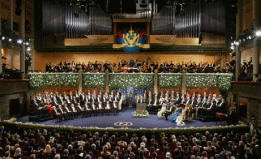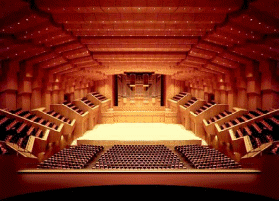Introduction
The world of architecture is magnificent and incredible. The buildings people got used to and consider common are unique and specific as there were people who put their hearts and souls into the creating of the masterpiece. Looking at the pieces of art created many years ago, many people try to compare them with modern buildings. The difference is significant, in some content. Still, similarities are also found. The color, the shape, the structure, and other architectural items are the main distinctive features that make the buildings different. Nevertheless, being similar in color and shape, the buildings are going to be still different as the general look, final appearance of the building depends on the architect who does his/her work with a lot of interest and energy. The main purpose of the paper is to present two buildings which were created in different countries separated by more than 50 years but still having one common feature, these two buildings are the concert halls which pursue the same purpose, Athens Concert Hall and Stockholm Concert Hall.
Stockholm Concert Hall

Starting the discussion with the Stockholm Concert Hall, it should be mentioned that it was built in 1926 (Ohlsen, 2004). The building project was created in 1920 when Ivar Tengborn managed to win “the design competition for the neoclassical and Art Deco Konserthuset” (Ohlsen, 2004, p. 58). Only six years have come from the day of the beginning of the building and the day when the first concert took place. The history of the hall creation is rather limited as nothing serious and extraordinary took place there. Still, the Stockholm Concert Hall is one of the most popular concert halls all over the world as the ceremonies devoted to awarding Noble prize winners take place there. Thus, the building does not inspire its external appearance till the moment you enter it. The whole beauty of the building is inside. The 1st of March, 1926 was the day when the first concert took place in the Stockholm Concert Hall with the famous music – “En saga, Rakastava, The Swan of Tuonella and the Second Symphony” (Barnett, 2007, p. 301).
Athens Concert Hall

Athens Concert Hall is the building that was founded more than 50 years later from Stockholm Concert Hall, in 1991 (Beranek, 2004, p. 334). The building is considered to be one of the “Europe’s most state-of-the-hall concert halls” (Kyriakopoulos, 2007, p.83). One of the peculiarities of the Athens Concert Hall is that it also includes the exhibition hall and the library. The Athens Concert Hall is also called Megaron. The Concert Hall is named Megaron, not by chance. Being used in the architectural sphere, the term “megaron” means “a long hall-like building with a porch open at the front and walled in on the sides” (Wright , 1997, p. 140). The same look as the Athens Concert Hall in Greece, the front sire is open while the side face is walled. The building was designed by Heinrich Keilholz in 1976 but the building had to be delayed for some years. Elias Scrubelos continued the building and presented the complete variant of the Concert Hall in 1991.
Contrast and comparison analysis of Stockholm Concert Hall and Athens Concert Hall architecture
The comparison of these two concert halls built with the difference of 65 years will show us the similarities as the general opinion about the rules for construction of specific types of buildings, such as concert halls, opera houses, music halls, and studios did not change, and the differences are going to be observed as the years change the attitude to art and beauty; with the duration of time fashion changes and the buildings created to have a different appearance. Relating to the examples of the concert halls that were chosen, the building’s form, colors, structure and general appearance are going to be discussed directed to the comparison and contrast analysis.
Starting with the general appearance of those concert halls, Stockholm and Athens, are rather similar in shape. The buildings are right-angled and the front side is opened. The side faces of those two halls are almost similar, simple walls in some places glassed-in, still the sidewalls of the Stockholm Concert Hall are not so smooth, the windows and balconies are noticed. The Athens Concert Hall is white, but at night it shades in blue due to the statue that is situated next to the building and which lights in blue at night. The Stockholm Concert Hall is blue in color.
Furthermore, the columns are significant in those two concert halls. First of all, it should be mentioned that they are present. Second, those columns are aligned that make the impression that the whole building, or at least its front side, is held on those columns. Here the similarities are finished. The Stockholm Concert Hall’s columns are different from the building, their shape is round and the color is grey. Those columns create the main emphasis of the whole building, the zest that makes it impossible not to notice the building. The columns of the Stockholm Concert Hall building create the “volumetric composition” (Quantrill, p.39). The columns in the Athens Concert Hall melt into the background; they are of the same color, white, and of the same shape, right-angled. The columns do not separate, still, they give some specific information. Considering the halls of different times and art directions, it may be noticed that most of them, still not all, are built in the same manner, with the columns on the front side.
These two concert halls are aimed at using symphonic concerts, presenting chamber music, for solicits, and for opera shows and theater performances (Beranek, 2004). Turning to the building characteristics of those two halls, it is significant to mention that the Stockholm Concert Hall had to be created according to the specific requirements. The design should have been met the place requests, one of the sides had to face the street, while the other should have been on the marketplace. Furthermore, being right-angled, the building tends to have a square shape (Nelson & Yale University, School of Architecture, 2007, p. 97). The Athens Concert Hall was projected and designed by one architect, but, due to some difficulties, the building of the hall had to be delayed and when it was started again it was completed by the other architect.
Looking inside the Athens Concert Hall and the Stockholm Concert Hall, two different places are seen. Though, the similarity is observed. First of all, the architectural and structural characteristics are rather similar. The ceilings of the buildings are created out of thick wood while the floor covering is parquet without carpet (Beranek, 2004). Furthermore, the shape of the concert halls inside is different. Considering picture 1, the Stockholm Concert Hall is round, with the scene inside the raw of seats that are distributed in the following way. The lowest raw is the most numerous and is situated in front of the scene in the middle. The rows are located on the same level, maybe just a little stepped. In front of this row of seats, there is a wall under which the orchestra is situated. There are rows of the seat that are designed as if it is the lengthy balcony on the two sides of the scene. The seats are placed in rows which are located on different levels. Three columns on each side of the balconies add to the magnificence of the room. The whole building seems to be small and cozy, but when being inside the huge size of the building does not stop surprising. The ceiling is raised high and there is the impression that the room is extremely huge.
The absolutely different impression is from the Athens Concert Hall. Having considered the outside appearance of the building, it is high time to look inside. On the contrary to the Stockholm Concert Hall, the Athens Concert Hall is oval inside. The ceiling seems to be too low, in comparison that another hall. Furthermore, the central rows of seats are situated in a stepped manner to give common opportunities for all viewers. The central rows are separated into two parts, those closer to the scene and more remote. Their central rows of seats are separated by two gangways. The side balconies are also separated and created in a form of different rooms, still without the walls. In front of the central rows of seats, there is the wall under which, like in the Stockholm Concert Hall, the orchestra is situated.
It is significant to notice that those two concert halls are extremely important for their countries, as they are more than just buildings. Having considered the architectural and structural peculiarities of the concert halls in Stockholm and Athens it was noticed that there was nothing specific in the buildings, still, the significance and importance of most architectural masterpieces of art are not in the formal appearance, but in the soul, the architects put there.
Conclusion
In conclusion, the Athens Concert Hall and the Stockholm Concert Hall are the buildings that were created at different times, more than 50 years difference, still, the similarity is observed. The columns at the front sides of the buildings, the round shape of the halls inside, and the materials the buildings are created of are indicative of the fact that while founding the building of the same purpose, the general look of the building remains the same. This may happen due to people’s associations. Still, the modern tendencies in the art are rather provocative and categorical, the modern art tries to withdraw from generally accepted canons and create something new and unique. Still, this tendency is rather new and it was not observed twenty years ago when the Athens Concert Hall was built. Though the differences also exist, the concert hall in Athens is more angled, whole those in Stockholm is more volumetric.
Reference List
Barnett, A. (2007). Sibelius. New Haven: Yale University Press.
Beranek, L. L. (2004). Concert halls and opera houses: music, acoustics, and architecture. New York: Springer.
Kyriakopoulos, V. (2007). Best of Athens. New York: Lonely Planet.
Larsson, U. (2001). Cultures of creativity: the Centennial Exhibition of the Nobel prize. Cambridge: Science History Publications.
Nelson, G. & Yale University, School of Architecture. (2007). Building a new Europe: portraits of modern architects: essays by George Nelson, 1935-1936. New Haven: Yale University Press.
Ohlsen, B. (2004). Stockholm. New York: Lonely Planet.
Quantrill, M. (1995). Finnish architecture and the modernist tradition. New York: Taylor & Francis.
Wright, G. R. H. (1997). Ancient Building in South Syria and Palestine. Leiden: Brill Academic Pub.